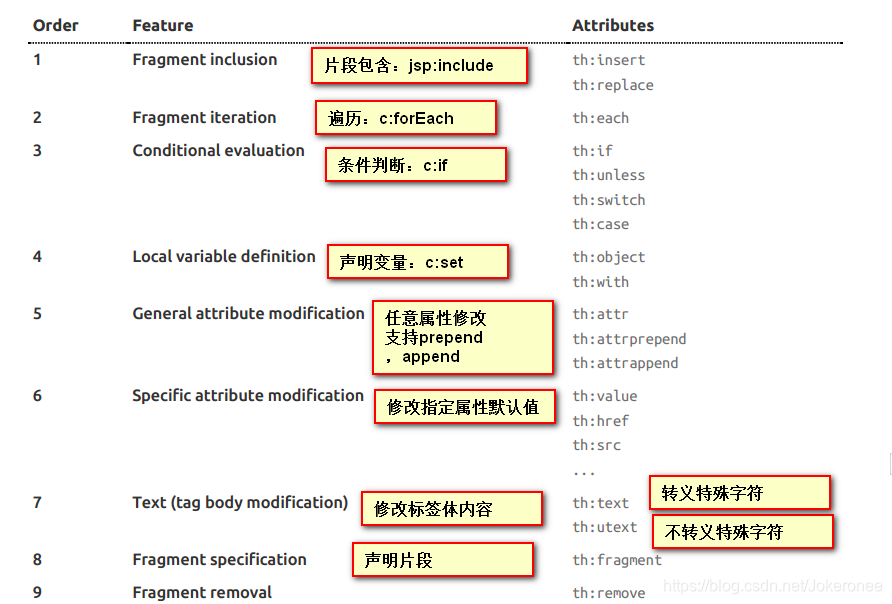在我们以前开发的时候,虽然现在已经前后端分离,但有时为了测试方便,我们还是会采用jsp技术,SpringBoot也当然支持,但默认是不允许的,我们需要引入它的各种依赖。可是在SpringBoot中使用jsp总会出现各种各样的问题,所以我们使用SpringBoot推荐的thymeleaf模版引擎技术来进行视图层的渲染
什么是模版引擎呢?
下面有一张图:

简单点来说就是我们先编好页面,然后在页面中留出占位符,接着从后端获取到的数据会经过我们所选用的模版引擎填充到占位符中,最终生产html来给用户显示。
thymeleaf
这里我们来介绍以下SpringBoot推荐的thymeleaf,它的语法相比jsp更简单,功能更强大。
首先我们要去使用它,先引入它的maven依赖
<dependency>
<groupId>org.springframework.boot</groupId>
<artifactId>spring-boot-starter-thymeleaf</artifactId>
2.1.6
</dependency>
切换thymeleaf版本
<properties>
<thymeleaf.version>3.0.11.RELEASE</thymeleaf.version>
<!-- 布局功能的支持程序 thymeleaf3主程序 layout2以上版本 -->
<!-- thymeleaf2 layout1-->
<thymeleaf-layout-dialect.version>2.2.2</thymeleaf-layout-dialect.version>
</properties>
在这里因为SpringBoot默认帮我们选择的版本号太老了,我们这里自己选用3.0.11,同时注意,thymeleaf需要有layout的支持,我们自己选用2.2.2版本
导入之后我们就开始开始使用thymeleaf了,创建一个html页面,导入一个约束名称空间
<html lang="en" xmlns:th="http://www.thymeleaf.org">
先简单写一个小程序入门thymeleaf
<!DOCTYPE html>
<html lang="en" xmlns:th="http://www.thymeleaf.org">
<head>
<meta charset="UTF-8">
<title>hello</title>
</head>
<body>
<h1 th:text="${hello}"></h1>
</body>
</html>
在${}里面可以直接取出request域中的数据,用法和jsp一样,所以我们往request域中存储一个数据
@Controller
public class HelloController {
@GetMapping("hello")
public String hello(HttpServletRequest request){
request.setAttribute("hello","leslie");
return "hello";
}
}
接着访问

可以看到可以访问成功,那这样和jsp有什么区别呢?别着急,这里有个自己学习时的笔记,记录了它自己的比较好用的功能。
语法规则
- th:text;改变当前元素里面的文本内容
th:任意html属性;来替换原生属性的值

- 表达式
Simple expressions:(表达式语法)
Variable Expressions: ${...}:获取变量值;OGNL;
1)、获取对象的属性、调用方法
2)、使用内置的基本对象:
#ctx : the context object.
#vars: the context variables.
#locale : the context locale.
#request : (only in Web Contexts) the HttpServletRequest object.
#response : (only in Web Contexts) the HttpServletResponse object.
#session : (only in Web Contexts) the HttpSession object.
#servletContext : (only in Web Contexts) the ServletContext object.
${session.foo}
3)、内置的一些工具对象:
#execInfo : information about the template being processed.
#messages : methods for obtaining externalized messages inside variables expressions, in the same way as they would be obtained using #{…} syntax.
#uris : methods for escaping parts of URLs/URIs
#conversions : methods for executing the configured conversion service (if any).
#dates : methods for java.util.Date objects: formatting, component extraction, etc.
#calendars : analogous to #dates , but for java.util.Calendar objects.
#numbers : methods for formatting numeric objects.
#strings : methods for String objects: contains, startsWith, prepending/appending, etc.
#objects : methods for objects in general.
#bools : methods for boolean evaluation.
#arrays : methods for arrays.
#lists : methods for lists.
#sets : methods for sets.
#maps : methods for maps.
#aggregates : methods for creating aggregates on arrays or collections.
#ids : methods for dealing with id attributes that might be repeated (for example, as a result of an iteration).
Selection Variable Expressions: *{...}:选择表达式:和${}在功能上是一样;
补充:配合 th:object="${session.user}:
<div th:object="${session.user}">
<p>Name: <span th:text="*{firstName}">Sebastian</span>.</p>
<p>Surname: <span th:text="*{lastName}">Pepper</span>.</p>
<p>Nationality: <span th:text="*{nationality}">Saturn</span>.</p>
</div>
Message Expressions: #{...}:获取国际化内容
Link URL Expressions: @{...}:定义URL;
@{/order/process(execId=${execId},execType='FAST')}
Fragment Expressions: ~{...}:片段引用表达式
<div th:insert="~{commons :: main}">...</div>
Literals(字面量)
Text literals: 'one text' , 'Another one!' ,…
Number literals: 0 , 34 , 3.0 , 12.3 ,…
Boolean literals: true , false
Null literal: null
Literal tokens: one , sometext , main ,…
Text operations:(文本操作)
String concatenation: +
Literal substitutions: |The name is ${name}|
Arithmetic operations:(数学运算)
Binary operators: + , - , * , / , %
Minus sign (unary operator): -
Boolean operations:(布尔运算)
Binary operators: and , or
Boolean negation (unary operator): ! , not
Comparisons and equality:(比较运算)
Comparators: > , < , >= , <= ( gt , lt , ge , le )
Equality operators: == , != ( eq , ne )
Conditional operators:条件运算(三元运算符)
If-then: (if) ? (then)
If-then-else: (if) ? (then) : (else)
Default: (value) ?: (defaultvalue)
Special tokens:
No-Operation: _
这些是在thymeleaf的官网上直接copy下来的,笔记加载注释里面了。
